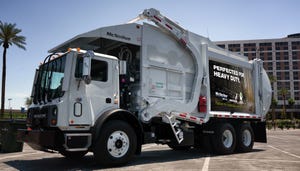Toughing Out The Plastics Crunch
February 1, 1995
Susan DeGrane
Demand and prices for plastic resins rose dramatically late last spring and may continue to climb well into midsummer. The trend has had dramatic repercussions in several facets of the waste industry.
Manufacturers of refuse carts, recycling bins and landfill products such as liners, geo-grids, geotextiles and drainage nets, have suffered outrageous cost increases - as much as 80 percent.
"You can't make up for it in a given year," said Ron Cimmino, the vice president of the solid waste division for Otto Industries, Char-lotte, N.C., a refuse container manufacturer. "An increase like this is dramatic. We weren't successful in passing it on to our customers. As a result, the profit margins have been squeezed dramatically."
"Listening to the news, the average person might wonder, since inflation is under control and oil prices are not up, why are plastics prices rising?" said Bill Henning, sen-ior vice president at Toter, Statesville, N.C.
Henning explained that plastic resin is made from ethylene, not oil; between ethylene price increases and higher demand, the cost of plastic has shot up dramatically. "Check the price of anti-freeze this year," Henning added. "Prices are high and supply is short because most of it is made from ethylene.
"Because of clauses in municipal contracts that restrict cost increases for any reason, what once looked like a good contract for a manufacturer may not appear the same today," Henning said. "When material prices in-crease by 80 percent in a short period of time, margins are severely impacted."
Industry manufacturers who use plastics also are handicapped by contracts that prevent them from passing costs on to their customers. Some, like Tensar Corp., an At-lanta-based manufacturer of structural components for landfills, have refused to do so for fear of losing market share in an extremely competitive environment. However, this concern is balanced out by the value of products that enable owners and operators to expand landfill capacities without expanding acreage, said Stephen Butchko, the vice president of technology development.
Tom Caltrider, president of Gundle Lining Systems Inc., Hous-ton, points out that a sharp rise in the cost of a commodity can stress any manufacturing industry. How-ever, plastic prices now are approaching levels they once held in the late 1980s.
"It's hard to convince our clients that our costs have gone up 70 percent, while our [products'] price has increased maybe 5 percent," said Joe Bar-nabee of Rehrig Pacific Co., Erie, Pa., a refuse cart manufacturer. "This affects our products across the board, but it does not affect our outlook as far as being able to do business. This is a temporary situation."
But Barnabee also agrees that eventually the industry's customers will bear the burden. "We'll pass this on to the customer - we have to, everybody will," he said. Barnabee adds that his company has kept its customers abreast of plastics price increases to prepare them for impending increases in his company's products' prices.
Gundle also anticipates that its competitors who buy polyethylene will be raising their prices, just as his company will, Caltrider said.
On the positive side, some recyclers have benefited from a demand for post-consumer materials that has far outstripped supplies and has let them raise their prices considerably. Now, they can begin to compete for a share of the market held by virgin resin producers whose prices have risen by astronomical proportions.
"The biggest issue is that more bottles need to be collected," said Luke Schmidt, spokesman for the National Association for Plastic Container Recovery (NAPCOR), Charlotte, N.C. But recyclers who want to gain a piece of the market may not have supply lots that are big enough to meet individual customer needs. And it's difficult to ob-tain larger quantities of post-consumer plastic because many com- munities are reluctant to set up plastic recycling, having already exhausted their budgets for recycling other materials like glass, paper and aluminum (see graph on page 26).
Prices of high density polyethylene (HDPE), the plastic in milk cartons and detergent bottles, have risen from 20 to 40 cents per pound. Man-y on the post-consumer supply side don't think that the trend will last. But Schmidt said the prices show no signs of letting up soon.
Some waste industry manufacturers who use virgin plastic resins speculate that, even as plastics production capacities expand to meet existing demand and the price surge tapers off, prices likely never will fall to previous levels.
Several factors have contributed to the high prices, high demand and the short supplies of plastics. For ex-ample, the recovering economy has boosted manufacturing of everything from automobiles and boats to toys and grocery bags. In addition, the cotton crop failures in Asia have pushed textile manufacturers to use both virgin and post-consumer poly-ethylene terephthalate (PET).
Post-consumer PET has found added value in over 50 new product uses, said NAPCOR's Schmidt. "In some cases 50 percent of polyester fiber in carpeting comes from recycled materials. It's being used in clothing, T-shirts, denim fabric, in ceiling padding, even car parts, like the bumper of the Ford Taurus." Post-consumer PET also was recently approved for use by the soft drink industry as packaging.
"Recyclers are already seeing the increases in revenues which are at an all-time high," Schmidt said. "But the switch-over varies according to the application. With some products it makes more sense to use recycled versus virgin. With others, it won't."
By regulation, landfill liner manufacturers are not permitted to use recycled materials in their products, but cart manufacturers can, and do.
Joe Barnabee, product manager for Rehrig Pacific Co., said the plastics crunch "has accelerated our ex-perimentation with recycled. We're looking for volumes we could potentially use in our garbage containers and we are discovering that we can use more than was expected."
Zarn Inc., Reidsville, N.C., is a re-fuse cart manufacturer whose beginnings are rooted in recycling. Zarn owns a recycling business that buys post-consumer HDPE, processes it and uses it to make carts. In hammering out a new contract for carts with a large municipality, Snyder said Zarn suggested carts which contained 50 percent post-consumer HDPE, much of which would be purchased from the municipality.
"This means Joe Blow can drink his milk and recycle the carton, which will be collected, processed in-to a cart (along with other milk cartons, plastic bottles and virgin HDPE) and eventually the container will return to his back yard. We are closing the loop on recycling. In this case, the consumer will know the end result of his recycling efforts," Snyder said. Using PCR isn't the ultimate solution to the plastics price crunch, he said, but "it helps."
Withstanding Pressure Otto Industries is a large consumer of virgin resin and also has used post-consumer HDPE in its trash containers since 1989. Cim-mino said that the content range should be between 10 to 25 percent for the material to flow properly and to achieve structural integrity at the finish. Beyond that range the carts begin to break, he said.
"Post-consumer already has a heat history and it will flow differently than a virgin resin in the mold process," Cimmino said. The polymer's physical strength is already affected by using the material once, he said.
Another drawback to using post-consumer plastic is the material's processing costs. For example, "as virgin resin goes up 80 percent, you can bet post-consumer goes up 40 percent," said Barnabee of Rehrig Pacific. "After processing, you're paying close to the same amount."
Packaging and automobile manufacturers are voracious plastics consumers, especially in today's recovering economy. Because they are the bigger consumers, they have been the least likely to receive allocations.
Many companies consume enough plastics to avoid the "pro-rationing" that affected many smaller customers. However, many smaller manufacturers turned to post-consumer materials for the first time, hoping to save costs and to avoid material shortages.
The Plastic Recycling Alliance Co. of Chicago manufactures Tenax Strap, a transparent green packing strap made from post-consumer PET soft drink bottles. The company was purchased by Illinois Tool Works (ITW), to make the packaging strap for ITW's other plastic products, including car components, hand tools and other packaging materials. To make the Tenax Strap, the Plastic Recycling Alliance has had to seek new sources for post-consumer PET. Materials Manager Mark de la Garza said, "There is a high demand (for post-consumer plastics) because there is not much of it out there."
Many recyclers are supplying more of their products to a wider range of manufacturers, and are realizing that manufacturers' demands can be tough. Their most stringent requirement is strict source separation.
"The problem is the streams are not that refined," said Cimmino. Contamination levels reportedly are high and uncertain for post-consumer plastics. "You get polyethylene terephthalate and PVC bottles ground up with HDPE. With consumer education, better separation seems to answer much of the contamination problem."
California leads a trend among states to mandate recycled content in newly manufactured plastic products. Some manufacturers are concerned that content requirements should not hinder their ability to maintain product integrity, nor re-quire them to pay exorbitant processing costs.
"Mandates are going on because of waste reduction," said Cimmino. But, as he points out, using recycled materials in some processes and for some products can cause breakage, so not everyone benefits. For some, productivity goes down and the risks are greater, Cimmino said.
Virgin plastic resin producers look to increase capacities and possibly a leveling off of prices by summer, according to Plastics News.
You May Also Like


